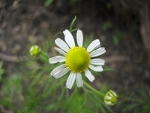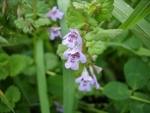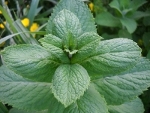-
Chamomile

-
Ground Ivy

-
Horsemint

- Mullein
- Tall Cinquefoil
- Wild Roses
- Yarrow
Herbs of Spring
Chamomile
Chamomile is one of the oldest favourites amongst garden herbs and its reputation as a medicinal plant shows little signs of abatement. The Egyptians reverenced it for its virtues, and from their belief in its power to cure ague, dedicated it to their gods. No plant was better known to the country folk of old, it having been grown for centuries in English gardens for its use as a common domestic medicine to such an extent that the old herbals agree that 'it is but lost time and labour to describe it.
Ground Ivy
From early days, Ground Ivy has been endowed with singular curative virtues, and is one of the most popular remedies for coughs and nervous headaches. It has even been extolled before all other vegetable medicines for the cure of consumption.
An excellent cooling beverage, known in the country as Gill Tea, is made from this plant, 1 OZ. of the herb being infused with a pint of boiling water, sweetened with honey, sugar or liquorice, and drunk when cool in wineglassful doses, three or four times a day. This used to be a favourite remedy with the poor for coughs of long standing, being much used in consumption. Ground Ivy was at one time one of the cries of London for making a tea to purify the blood. It is a wholesome drink and is still considered serviceable in pectoral complaints and in cases of weakness of the digestive organs, being stimulating and tonic, though it has long been discarded from the Materia Medica as an official plant, in favour of others of greater certainty of action. As a medicine useful in pulmonary complaints, where a tonic for the kidneys is required, it would appear to possess peculiar suitability, and is well adapted to all kidney complaints.
Horsemint
The English Horsemint (Mentha sylvestris) is a strong-scented plant, frequent in damp, waste ground, usually growing in masses, with downy, egg-shaped leaves tapering to a point, with finely toothed margins, their undersides very white with silky hairs. The flowers are in thick cylindrical spikes, which are often interrupted below; the corollas are lilac in colour and hairy.
The taste and odour of the plant resemble those of the Garden Mint.
The dry herb yields about 1 per cent of essential oil, having carminative and stimulant properties.
Culpepper says:
'It is good for wind and colic in the stomach.... The juice, laid on warm, helps the King's evil or kernels in the throat.... The decoction or distilled water helps a stinking breath, proceeding from corruption of the teeth, and snuffed up the nose, purges the head. It helps the scurf or dandruff of the head used with vinegar.'